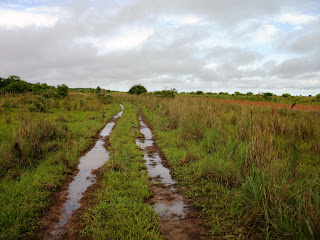






In Central Venezuela I left the Orinoco River and headed in a Southerly direction towards the Gran Sabana and the famous Cainama National Park. In contrast to the rest of Venezuela where I´ve been so far, the Gran Sabana is a grassy highland fringed by flat-topped rocky mountains in the distance. I had to climb up to this area on a 30-km section of road aptly named La Escalator (fortunately it was raining as usual, so at least I didn´t overheat). Due to it´s altitude this region is also a bit cooler than the tropical lowlands. The Angel Falls are also in this park (although getting there involves taking a guided tour from a different place to where I was cycling). After turning South from the Orinoco I at first passed through some towns and farming countryside before getting to the Gran Sabana. Asking for directions from a group of men in one town where I arrived after dark, one man suggested that I camp amongst the scrap metal under a roofed area next to his house. He then proceeded to prepare an interesting dinner for me and himself amongst the tools and scrap metal in his kitchen, and offered me plenty of coffee which he served in a plastic margarine container (his overgrown back yard served as a toilet, which seems to be quite common in some rural areas of Venezuela). Petrol is dirt-cheap in Venezuela, and as a result there are many big old crab-walking American-model V-8 cars and trucks on the road. Drinking and driving seems to be a national sport, and in the National park where one can spot the litter in the roadside grass, I counted 235 empty beer cans in a single km only on one side of the road. I also amused myself in other ways, such as hanging dead snakes over my bike and taking pictures of them. Distances are given in hours (not km), and I´ve found that some people think I average about half the speed of a car! Whether I ask or not, I´m often informed that the road ahead is flat (plano), which it has never been. At the Southern extreme of the Gran Sabana is the Brasilian border, where I now find myself. Distances cycled on this section were:- Upata 92 km; Guasipati 114 km; El Dorado 105 km; San Isidro 104 km; Rio Kamoiran 84 km; San Francisco De Y. 81 km; Pacaraima (Brasil Bdr) 84 km. The total so far in South America is 20 869 km, and the total distance I´ve cycled so far on this trip is 87 356 km.




























